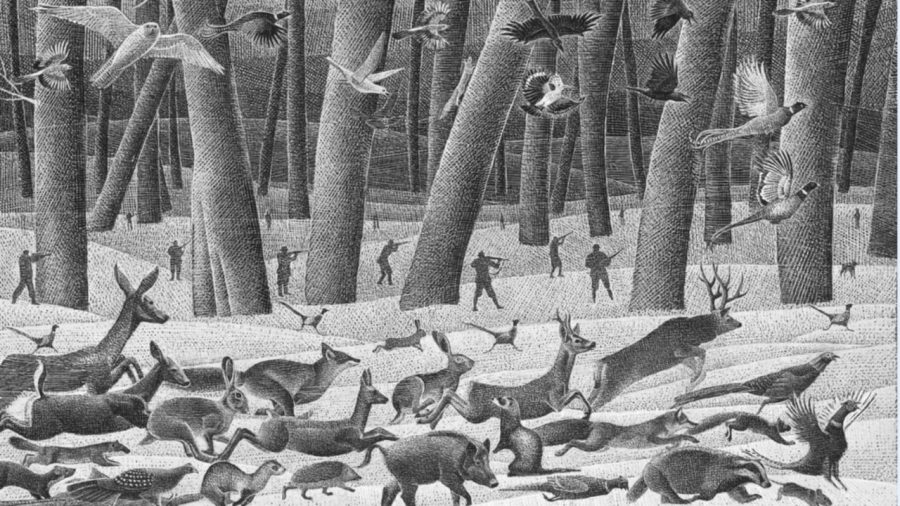Is ‘Bambi’ about Jewish persecution, Zionism or something else?
The life of Felix Salten, author of “Bambi: A Life in the Woods” was marked by antisemitism.
Published August 21, 2022
Editor’s note: We’re republishing this story, originally published on Jan. 28, 2022, for the 80th anniversary of the American theatrical release of the animated film “Bambi,” which debuted in U.S. theaters on Aug. 21, 1942.
A prince is born in the forest.
In this idyllic, verdant Eden, birds summon a menagerie of adorable woodland creatures – a mouse washing its face with a drop of dew, a chipmunk using a squirrel’s tail as a blanket. A rabbit thumps his foot on a log and announces the royal birth. The animals gather in a hollow to witness the nativity, cooing over a sleeping fawn. A magisterial owl says, “Well, this is quite the occasion.”
The owl and the rest of the animals congratulate the mother, and all stand in awe as the tiny, white-flecked prince takes his first, faltering steps.
This is how most of the world met Bambi, in a 1942 film by Walt Disney. The source material has a different origin for our hero.
“Bambi: A Life in the Woods,” the 1922 novel by Felix Salten, first translated into English in 1928 by future Soviet spy Whitaker Chambers, begins when Bambi is born in the middle of a thicket, “one of those small hidden places in the forest that appear to be open yet are shielded on all sides.”
ADVERTISEMENT
In this tiny enclosure, “so small that there was barely enough room for him and his mother,” Bambi is shielded from danger in his earliest, most vulnerable moments. The only one there to greet his birth is a magpie – a nosy one, who Bambi’s mother does not want there, perhaps fearful of too much attention. As Jack Zipes, the author of a new translation of Salten’s novel, “The Original Bambi,” states in his introduction, to be born as an animal in the forest is to be “born to be killed.”
Zipes, a professor emeritus of German and comparative literature at the University of Minnesota, at first dismissed a proposal from an academic press to translate Salten’s novel for its 100th anniversary, knowing it primarily through the “miserable Disney film.”
But when Zipes did his research, he immediately noticed the stark difference between the “high aristocratic” birth of the Disney deer and the sheltered, precarious infancy of Salten’s original buck. He was determined to correct people’s misapprehensions about the story’s meaning. “Bambi,” Zipes offers, as others scholars did before him, can be read as an allegory for Jewish persecution.
“Whether he knew it or not, and I think he did know it, ‘Bambi’ sort of predicts what is going to happen with the Holocaust,” he said.
In the book, the animals are constantly hunted. Bambi’s mother is not the only one to die violently; all manner of fauna are disemboweled by their neighbors in the forest or shot by the horrifying “Him” (humankind). The jays and magpies who greet Bambi’s birth are most conspicuous when alerting deer and pheasants to man’s encroachment. Bambi’s first lesson after learning to walk is how to approach an open meadow, where, at the slightest hint of danger, he must be prepared to dart back to the trees.
Zipes and others have argued that “Bambi” is Jewish because Salten was – though his Jewishness took on different forms throughout his life.
Born Siegmund Salzmann in Pest in 1869, to parents who soon after relocated the family to Vienna, Salten changed his name in his teen years in an effort to “unmark” himself as a Jew. He considered converting to Catholicism as he endured the antisemitism of his neighbors, classmates and teachers, and primarily identified as Austrian. Striving to overcome the lost fortune of his entrepreneur father – the son of a rabbi – Salten joined a group of cafe-frequenting writers known as Young Vienna, which included major figures like Arthur Schnitzler and Stefan Zweig.
The always over-leveraged Salten took work where he could get it in a number of mediums, but was primarily known as a journalist, critic and hanger-on to the Habsburgs. Salten was also an animal lover and avid hunter who spent many hours observing the wildlife on his hunting preserve, which no doubt informed his animal stories. Later he would distinguish himself from the other members of Jung-Wien by serving as an outspoken advocate for Jewish statehood following the example of fellow Hungarian-Jewish journalist Theodor Herzl.
Herzl’s Zionism appealed to Salten’s robust sense of self-empowerment and self-invention. As Paul Reitter notes in his 2013 Jewish Review of Books essay “Bambi’s Jewish Roots,” Salten wrote a column for Herzl’s paper, Die Welt, and would publish a substantial profile of the Zionist leader after his death in 1904.
In a harsh critique of Zipes’ translation for The New Yorker, Kathryn Schulz argues that Salten’s Zionism was conflicted, noting that his column for Die Welt was anonymous and that he “refused to set foot in the newspaper’s offices.”
But Reitter, a professor of Germanic languages and literature at Ohio State University, who wrote the afterword to a translation of “Bambi,” that will arrive from New York Review Books this summer, takes issue with Schulz’s characterization. While Salten’s column was anonymous, he said, many of his pieces for Die Welt and other Zionist writings, including a 1925 travel book on Mandatory Palestine, appeared under his own name. Salten was also a very public and persuasive Zionist speaker at two “festive evenings” at the Bar Kochba Society in Prague in 1909 and 1911, where he was reported to have upstaged no less an eminence than Martin Buber.
While Schulz implies that a Nazi notion of “Bambi” as a parable of Jewish persecution was the chief reason that it was burned, Reitter believes Salten was more likely marked for the bonfire for his modernist sensibilities, pornographic potboilers and, not least significantly, his Zionist affiliation.
“My own interpretation is that the allegorical representation of Jewish experiences is of a very particular kind,” Reitter said of “Bambi.” “He never really thought seriously about immigrating to Palestine and like a lot of Zionist figures, he was in his way very much an ardent assimilationist.”
Salten was certainly distressed by antisemitism, Reitter said, and wrote passionately about it, but interestingly most of those pieces came before 1918, well before anti-Jewish bigotry intensified as Austrians and Germans blamed Jews for the loss of World War I. The thread of Jewish themes Reitter observes most strongly in “Bambi” has less to do with pervasive persecution than it does with the peculiar content of Salten’s Zionist writing, which called for Jewish “regeneration and renewal through art.”
When Reitter reads how Bambi is frightened and awed by the “primordial” mating call of the kingly giant elks, he detects a direct echo of Salten’s call for Jews to reclaim the “mother sounds” in “the books of Job and Solomon.” It seems to me plausible that, in referring to his deer as princes, Salten is indicating this noble past, which, but for the constant threat of death or deracination, might flourish.
The Zionist reading appears to date back to a 2003 essay by Iris Bruce, who saw the Old Prince – or stag, who may or may not be Bambi’s father – as a kind of Herzl figure, leading Bambi to safety in a secluded part of the forest. Indeed, it is the Old Prince’s guidance of Bambi that informed Zipes’ interpretation of “Bambi” as a classic bildungsroman, where a mentor shows the ropes to a young man making his way in the world. Schulz agrees that of all the plausible messages of the book, the main takeaway is the Prince’s instruction that one must live alone or die exposed.
“‘Bambi’ is not a parable about the plight of the Jews, but Salten sometimes regards the plight of the Jews as a parable about the human condition,” Schulz concludes. “The omnipresence and inevitability of danger, the need to act for oneself and seize control of one’s fate, the threat posed by intimates and strangers alike: this is Salten’s assessment of our existence.”
That Salten’s existence was one of a Jew in Austria does seem to color some of the specifics, however.
As both Schulz and Zipes observe, the story of Bambi’s cousin Gobo appears to be a pointed condemnation of the dangers of assimilation for a minority group that will never truly belong. The Old Prince pities Gobo for being domesticated and collared by humans. Gobo, in turn, makes excuses for the vicious dogs and humans, whose benevolence is purely conditional (“if someone serves Him, He’s good to them”). Gobo dies by the gun of a hunter, divorced from his roots and with the false belief that all humans accept and love him.
The picture is naturally sharper, and more poignant, when one knows that Salten, as assimilated a Jew as could be found in Austria, with connections even to royalty, died in exile in Switzerland in 1945, having fled the Nazis after a period of denial. He too, for too long, believed himself safe.
Between Gobo’s tragedy and lines like “Will he ever stop persecuting us” and “He’s murdered us ever since we can remember,” a readymade read of the Jewish plight is perhaps too easy a destination, but nonetheless a valid one. The Owl’s sage words to Bambi, meanwhile, that “you can’t stay forever in the same place,” likewise make a compelling case for the protagonist as a rootless, roebuck cosmopolitan.
With regard to that bourgeois nature, one of Zipes’ aims in translating “Bambi” away from the mistake-riddled text of Chambers, is to restore what he views as the mannered, “Viennese Jews in cafes” dialect of the animals. (Schulz says that the Chambers translation is “the better one” and quotes only from his book; others have noted Chambers’ penchant for obscuring Salten’s human nouns – the deers’ impressive “crowns” are “antlers,” for instance – for one’s truer to nature.)
Reitter, however views Salten’s animal dialogue, as translated in his edition by Damion Searls, as connoting something altogether different. In the melancholic, whimsical chattering of polecats, martens and deer he hears the style of the Viennese feuilletons Salten was known for.
“Bambi,” Reitter says, “brings together all of the different things that Salten did in his career. He had a very diverse career as a writer and some people made fun of him for that.”
While encompassing Salten’s contradictions as a Zionist and assimilationist, a pornographer and a children’s writer, a royalist and admirer of Lenin and a hunter and compassionate lover of animals, his ouvre lends credence to a proposed animal counterpart. Not a deer, in fact, but a fly.
Reitter said the same year “Bambi” was published, Franz Blei wrote in his “Great Bestiary of German Literature” that the “Salten larvae” emerged as a “green or blue or black-and-yellow fly, depending on the color of the wastewater over which it lives out its one day.”
Salten was constantly reinventing himself both in his work and personal philosophy and, for that reason alone, it may be tricky to insist on any one interpretation of his most famous work. But however strident Zipes’ case for a Jewish reading may be, it’s not just the persecution he emphasizes. He also highlights the existential musings of two leaves in winter, the complicated complicity of animals in hunting and even the need for humans to become more like animals to be truly humane. More than anything, he hopes his translation dispels the sentimental simplicity of the Disney film he grew up with.
“If you read this novel and go back and look at the film it’s putrid,” said Zipes. “My gesture as an academic is to set the record straight.”
















